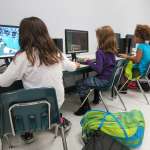Most children are aware of the environmental issues facing our planet - they may have seen climate change protests on the news or the effects of a changing climate on nature programs.
It is important that they have a clear understanding of what causes climate change, so they can be informed enough to prepare themselves for the fight to protect our planet as they get older.
Here are some simple greenhouse effect experiments you can use at home with kids of all ages so they can learn more about the greenhouse effect, global warming and sustainability.
Related: 10 Eco-Friendly Earth Day Crafts for Kids
What Is The Greenhouse Effect, Global Warming And Climate Change?
We sometimes use these terms interchangeably but it’s really important when talking to children that we are very precise about the language we use.
The greenhouse effect is a natural phenomenon that keeps the earth warm enough for life to survive. Infrared radiation (heat waves) from the sun hits the earth’s surface and warms it up.
Looking to Boost Your Child's Creativity? Let Them Play Minecraft
Playing Minecraft increases creativity, according to a new study. There’s a catch though—it only works under the right circumstances. Read More
The Earth emits radiation back towards space, but some radiation is trapped within the atmosphere, keeping the Earth warm. The gasses that trap heat are called greenhouse gasses, which include water vapor, methane and carbon dioxide gas.
So far, so good - right?
Well, the problem is that because of human activities, mainly the burning of fossil fuels in power stations and vehicle engines, we are producing more greenhouse gasses.

This increase in carbon dioxide gas, as well as other emissions like nitrous oxides, means that more heat energy is being trapped in the atmosphere leading to the Earth’s average temperature increasing. This is called global warming.
Climate change is all the effects of global warming that we are starting to see on the planet, such as extreme weather events, flooding, rising sea levels and warmer summers. These changes have detrimental effects on humans as well as plant and animal species.
Simple Greenhouse Effect Experiment For Preschoolers
You might not have a greenhouse in your yard but for a great example of this phenomenon, look no further than your own driveway! You can observe all the principles of the greenhouse effect in a parked car in the sun.
You will need:
- A parked car in a sunny spot.
What to do:
Sit inside the car and talk about what you can feel and how this is like the greenhouse effect.:
- Sunshine (solar radiation) passes easily through the glass to heat objects in the car's interior - remember how hot the car seats get in summer? This is like the sun heating up the Earth’s surface.
- The glass in the car's windows now begins to act like the greenhouse gasses in the earth’s atmosphere, trapping the heat energy and preventing it from leaving.
What happens:
The temperature inside the car gets higher than the surroundings outside - it can get to over 120 degrees Fahrenheit (49 degrees Celsius). This is just like the Earth’s greenhouse effect, keeping our planet warmer than space. You can explain that this is a good thing because without it the Earth would be too cold to live on!
Greenhouse Effect Experiment For Elementary Schoolers
Elementary kids can build a simple model of the greenhouse effect, using a plastic bag to represent the atmosphere.
Kids can observe how the bag traps heat, making it warmer inside. It also provides a good opportunity to practice using a thermometer to measure temperature.
You will need:
- Two large glasses, or glass bowls of the same size
- Ten ice cubes
- Cold tap water
- Clear plastic bag.
- A warm spot - this can be a sunny windowsill or use a heat lamp/light bulb as a heat source
- Thermometer - optional
What to do:
- Put the same amount of water and five ice cubes into each glass or bowl.
- Cover one with the plastic bag. This represents the atmosphere around the Earth. Leave the other one uncovered.
- Put both in a warm spot. Watch them to see what happens.
- If you have a thermometer, you can measure the temperature of the water after an hour.
What happens:
The ice cubes in the covered glass will melt first, because the water inside will get hotter than the uncovered glass. This is because the plastic bag traps the heat inside, acting like the atmosphere around the earth.
Greenhouse Effect Experiment For Middle Schoolers

Our Earth’s poles are covered in ice. In the Arctic, the ice is mainly sea ice, which means it is floating on top of the ocean. In Antarctica, the ice is mainly resting on top of land.
The ice at both poles is melting due to global warming. In this simple activity, children can see what happens to sea levels when ice at each pole melts.
You will need:
- Two large plastic tubs half full with cold water
- A small bowl, or some large pebbles
- Ice cubes
- A waterproof pen
What to do:
- Add the bowl upside-down into one of the tubs, so the bottom is above the water, or use the pebbles to form a mound in the water.
- Add 4 ice cubes to the top of the bowl, or pebble mound. Explain that this is representing the land ice in Antarctica.
- Add 4 ice cubes into the other tub of water so they float on the water. This is the sea ice in the Arctic.
- Use the pen to mark the level of the water in each tub.
- Talk about what they think will happen to the ice cubes and the water level in each tub.
What happens:
The ice cubes will melt. In the land-ice tub, the water level will rise but in the sea-ice tub, it will stay the same.
This doesn’t mean that rising sea levels are only a problem in the southern hemisphere though as all the world’s oceans are joined together!
Greenhouse Effect Experiment For Teens
Older children will be able to plan their own experiments, using ideas about changing variables and using controls. In this activity, they plan an experiment to find out the effects of changing variables on a model of the greenhouse effect and also learn about chemical reactions.
What you will need:
- Five empty glasses or jars of the same size.
- Measuring spoons and cups - to make sure amounts used are the same to make it a fair test
- Baking soda (bicarbonate of soda)
- Vinegar
- Plastic wrap
- A warm spot - this can be a sunny windowsill or use a heat lamp/light bulb as a heat source
- Thermometer
- Sticky labels and pen - to label the glasses
What to do:
- In one of the glasses, mix a teaspoon of baking powder with some vinegar so it bubbles. The bubbles are caused by a chemical reaction, releasing a new substance - carbon dioxide gas. The gas can be trapped inside by putting plastic wrap over the top.
- Talk about the fact that carbon dioxide is a greenhouse gas because it is able to trap heat.
- Ask the child to plan an experiment to prove this. There are several ways of doing this. The ideal method would be to set up several glasses:
- A. Empty
- B. Empty with plastic wrap over the top
- C. Vinegar with plastic wrap
- D. Baking powder with plastic wrap
- E. Baking powder and vinegar with plastic wrap.
- Glass E is the only one with high levels of carbon dioxide, released from the chemical reaction.
- Glasses A-D are the controls in the experiment. The control glasses are there to show that it must be the carbon dioxide inside the glass, and no other variable, making a difference to the temperature inside.
- Leave the glasses in a warm spot and measure the temperature after 30 minutes. Talk about what they think will happen and why (a prediction).
What happens:
Glass E should show the highest temperature. The carbon dioxide inside the glass traps the heat, just like carbon dioxide in the atmosphere around the earth.
Other Ways to Discuss Global Warming and Climate Change with Kids

There are other things you can do at home to learn about the greenhouse effect, global warming and climate change. Here are a few ideas:
1. Go online and use NASA’s Climate Change Time Machine
NASA’s Climate Change Time Machine shows how the Earth has changed over time. Kids can see with their own eyes into the past and ahead to the future to find out how the planet could be affected by climate change.
2. Talk about your carbon footprint as a family
Use an online calculator to find out how much carbon dioxide your family releases in a year. And then talk about how you could reduce it. Make pledges as a family and stick your list up in the house to remind everyone to stick to it.
3. Discuss day-to-day changes without panicking
Your kids may have noticed warmer summers, more extreme weather events, and endangered species. Choose something that resonates with them and ask them to do some research into this.
Note: You don’t want to panic your kids too much over these changes, as it is easy for them to feel “hopeless.”
Instead, let kids ask questions, and discuss proactive, small things they can do to be more green like using reusable dishes, donating clothes rather than throwing them out, or biking/walking more over using the car!
For more ideas for teaching sustainability to kids, check out our blog on 5 Ways to Get Kids to Care About the Environment!



